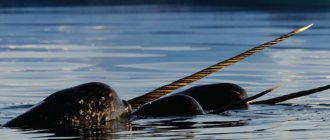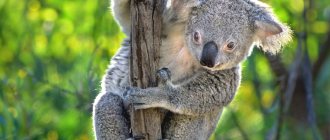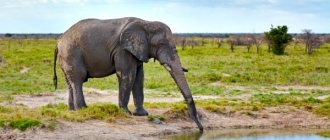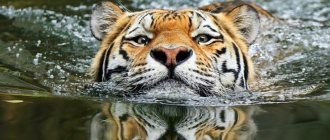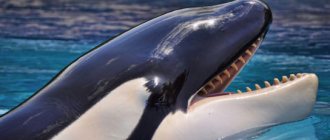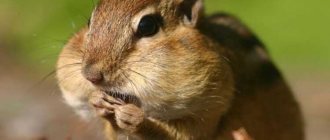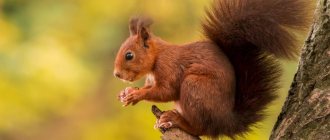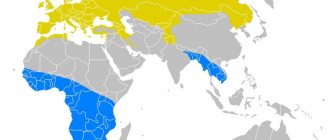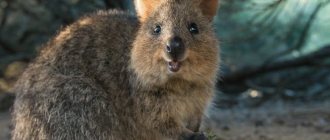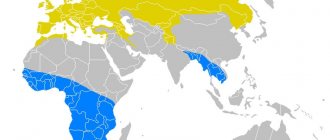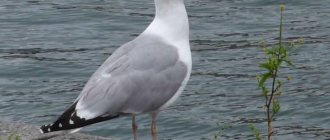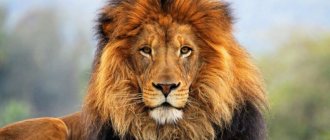Walruses (Odobenus rosmarus) is a genus of mammalian pinniped predators from the walrus family. The animal received its Latin generic name for its powerful long tusks: its translation sounds like “ moving on teeth».
The genus is represented by one extinct and two modern subspecies. Walruses have amazing resistance to harsh climates and are able to spend two-thirds of their lives in icy water. In Russia, animals are classified as rare and are under state protection.
Characteristics and description of the animal
According to paleontologists, walruses descended from land predatory mammals and are closely related to bears. Unlike their ancestors who moved on land, modern members of the family have characteristic features of adaptability to long-term stays in water. These include changing the shape of the body and limbs, which are transformed into flippers, the ability to hold one's breath and regulate the speed of the heart rate to reduce oxygen consumption while underwater.
Walruses of the Arctic deserts have also adapted to life at low temperatures. They have durable skin up to 10 cm thick. In addition, the body of walruses, seals and other northern animals accumulates a large amount of subcutaneous fat deposits, the thickness of which can reach 15 cm. A thick layer of fat maintains a stable body temperature even in very severe frosts and winds.
Walruses are social animals. They live in small groups of several dozen individuals or in larger herds. With seasonal sexual separation of herds, a walrus rookery, consisting of females and calves, can consist of 2-3 thousand individuals.
Quiet hour
A herd of pinnipeds lives as one large family, in which there is mutual assistance to each other and joint care of the growing offspring. The whole herd of walruses go in search of food, and during rest several individuals monitor the territory surrounding the rookery and give a signal in case of danger.
The average life expectancy of walruses is 35-40 years.
What does it look like
The Arctic walrus is a fairly large marine animal with a massive body tapering towards the rear. Its appearance has the following features:
- the head is small, round, with small eyes, a wide muzzle and two vertically located elongated fangs protruding from the upper jaw;
- the lower part of the muzzle is covered with several rows of thick, hard and laterally flattened hairs, which help the animal navigate at depth in low light conditions;
- the front fins are shorter than those of other pinnipeds, the structure of the rear fins allows for bending at the heel joint, due to which they also take part in movement;
- the skin is rough, with many folds, and in males it is covered with numerous growths.
In young individuals, the skin is brown; with age, the color becomes noticeably lighter. The hair present at birth gradually thins, and by old age the hair falls out completely.
How much does it weigh
Walruses are large marine mammals. The body weight of sexually mature individuals depends on the species and sex of the animal. Thus, the weight of an adult walrus of the Pacific subspecies reaches 2 tons, and of the Atlantic subspecies - 1.5-1.7 tons. Females are usually about a third smaller than males.
What sounds does a walrus make?
What is the difference between a walrus and a seal?
Despite many similar characteristics among pinnipeds, the walrus is easy to distinguish from other representatives of the group - seals.
| Walrus | Seal |
| Body length is 3-4 m | Body length - 2-2.5 m |
| There are no external auditory openings | There are small openings in the ear canal |
| Walrus baleen is hard, short, the hairs are arranged in several rows | The mustache is thin and long |
| Only young animals have fur; adults have almost smooth skin. | The body is covered with thick and soft fur |
| They move on land in small steps, pulling up their tail and leaning on their front flippers. | They crawl on land |
ELEPHANT
You should know it
- International scientific name: Odobenus rosmarus.
- Conservation status: vulnerable species.
- Characteristics: There are two subspecies of walruses: Pacific and Atlantic. The weight of an adult large Pacific male sometimes reaches 1.7-2 tons, and an adult female - up to 1.2 tons. The body length of males of this species varies from 2.7 to 4.5 m, females - from 2.2 to 3. 7m. The Atlantic species is 10-20% smaller than the Pacific one.
- This is interesting: life expectancy, both in the wild and in captivity, is about 40 years.
Types of walruses
The official biological classification distinguishes two modern subspecies: the Atlantic walrus and the Pacific walrus. Some sources contain mention of another species - the Laptev walrus.
- The Atlantic subspecies is common off the coast of Canada and Greenland. In the last century, it was subjected to significant extermination, as a result of which the population decreased to 15 thousand individuals.
- The Pacific walrus is distributed in the north of eastern Siberia and Alaska. It differs from the Atlantic in the shape of its muzzle and more impressive size.
- The Laptev walrus is endemic to the Laptev Sea. According to the results of genetic studies, it belongs to the Pacific subspecies, being its small isolated population. The Red Book of Russia classifies them as rare vulnerable subspecies.
Population and species status
Photo: Walrus animal
There is no exact information on the number of walruses today. According to rough estimates, the number of representatives of the Pacific subspecies is at least 200 thousand individuals. The number of Atlantic walrus is an order of magnitude lower - from 20 to 25 thousand animals, so this subspecies is considered endangered. The smallest population is the Laptev population. There are between 5 and 10 thousand such walruses left today.
Not only human activity, but also global climate change has a significant impact on the population of these animals. In particular, there is a reduction in the extent of pack ice and its thickness. Namely, it is on this ice that walruses form their rookeries for mating and childbirth during the reproductive period.
It is believed that due to climate change, there has been a decrease in suitable resting areas for walruses near their optimal feeding areas. Because of this, females are forced to be away longer in search of food, and this also affects the feeding of the cubs.
Due to the decline in the number of walruses, their commercial harvest is currently prohibited by law in all countries. To a limited extent, fishing is allowed only to indigenous peoples, whose existence is historically closely connected with walrus hunting.
Where do they live?
Walrus colonies are found in Arctic and subarctic waters. Habitat: coastal zones of the Arctic Ocean.
Where live
The natural habitat of the walrus is ice-covered areas near the coasts of Europe, Asia, North America, and Arctic islands with a depth to the bottom of 100-150 m. Pinnipeds do not settle near vast unfrozen water spaces and do not establish rookeries on pack ice.
Walruses are characterized by seasonal migrations. In the fall they move to the ice areas of the Bering Sea, and in the spring they return to their usual habitats in the Chukchi Sea. Males and females of the Pacific subspecies can cover up to 3,000 km during migration, moving by swimming and on drifting ice floes, while females with cubs swim further than males.
There is no detailed and reliable information about the migrations of Atlantic walruses due to a significant reduction in the size of this population. Presumably, they do not make such long journeys as their relatives.
Habitat
Walruses live on the Arctic coast. They also settled on nearby islands in Arctic waters.
Populations are found in Greenland, Iceland, the Spitsbergen archipelago and the Red Sea.
In the summer, most pinnipeds concentrate in Bristol Bay, but they do best in Alaska in the Tread Sea.
Walruses are migratory animals, so they can be found in the northern waters of eastern Siberia.
How do they reproduce?
Puberty in walruses occurs at 5-6 years. The ability to reproduce in adults remains up to 15-20 years.
The mating season, depending on the region, occurs in late spring or early summer. During this period, usually calm and non-aggressive males often engage in fights, during which they can inflict serious, but not fatal, wounds on each other. Walruses mate in water, with the largest and strongest males covering several females from their herd.
A year later, at the same time, females bring one calf weighing 40-50 kg and up to 1 m long, while the male walrus cubs that are just born are noticeably larger than the females. A newborn walrus calf has no teeth and is covered in light gray fur. Babies begin to swim from the first days of life; in case of danger, they dive into the water after their mother.
For the first six months, walruses eat only their mother's milk, then they begin to gradually switch to solid food. The female walrus continues to feed the calf with milk until the age of two.
Grown-up walruses remain in the maternal herd until puberty. Males then usually separate to form their own herd or to join larger aggregations of adult males during the seasonal separation of the sexes.
Features of character and lifestyle
Photo: Walrus Red Book
Walruses are herd animals. Typically, each herd is between 20 and 30 walruses in size, but some rookeries have hundreds or even thousands of animals grouped together. Each flock is dominated by the strongest and largest male. The rest periodically sort things out with him and try to take away the title. The subject of dispute is almost always the females.
In a herd, animals often lie very close to each other, due to the limited area of \u200b\u200bland or ice floes. Often you have to lie on your side, sometimes resting your head on a nearby walrus. And if there is very little space, then they can lie in two layers. The entire rookery is constantly “moving”: some animals go into the water to eat or cool down, and other walruses immediately return to their place to sleep.
An interesting fact: at the edges of walrus rookeries there are almost always sentinels who, having noticed the danger, immediately notify everyone else with a loud roar. After such a signal, the entire herd rushes into the water as one.
In relation to other animals and to each other, walruses are for the most part peaceful and friendly. In addition, female walruses have a very developed maternal instinct, so they selflessly protect their cubs when danger appears, and take care not only of their own offspring, but also of other people’s cubs. They are also very sociable. Any adult walrus in the herd allows any calf to climb onto its back and lie there to rest.
Natural enemies of walruses
Adult animals, due to their impressive size and sharp, strong tusks, have virtually no natural enemies. Only polar bears can attack them on land. As soon as a herd of pinnipeds dives into the water to search for food, the bear sets up an ambush near the ice hole. When the walrus tries to get to the surface, the predator deals him a stunning blow and finishes him off. A duel between two animals on land often ends in the victory of the walrus, so bears prefer to hunt cubs and juveniles.
Underwater, walruses often become victims of pods of killer whales.
POLAR BEAR
The fine for killing a walrus is from 21,000 rubles
Article on the topic
The rarest friend. 10 endangered species of animals The Atlantic and Laptev walruses are listed in the Red Book; there are just over 20 thousand individuals left in the world. The hunting of walruses is prohibited throughout the world, including in Russia. Only the indigenous inhabitants of Chukotka (where Pacific walruses live) have the exclusive right to hunt these animals in order to maintain their traditional way of life. For everyone else, the fine for catching Pacific walruses is 21,000 rubles, for catching Atlantic and Laptev walruses - 33,400 rubles.
What role do tusks play in the life of a walrus?
Walrus tusks are modified fangs of the upper jaw. They grow in individuals of both sexes, but the tusks of males are usually much longer and thicker. The growth of fangs begins in cubs from 5-6 months, by the time they are one year old their length reaches 10 cm, and by the time of puberty - 70-80 cm. The maximum recorded sizes of the fangs of an adult male are: length - 1 m, diameter - 8 cm, weight - 5.5 kg.
In walruses, tusks perform several functions:
- Using sharp and strong teeth, the animal fights off predators that attack it.
- With elongated teeth, walruses loosen the soil at the bottom of the ocean, then selecting mollusks and crustaceans from it.
- Walruses often use their upper tusks as an ice axe, cutting holes in the ice to descend to the bottom in search of food. The tusks help the clumsy and massive pinnipeds move on the ice and get out of the water onto the shore.
- Observations of the behavior of groups of walruses showed that males with the most massive and longest tusks manage to achieve a higher status in the hierarchy.
Nutrition
The main food of walruses is found on the seabed - these are elasmobranch mollusks. Sensitive whiskers on the animal's face help to detect their location. With its fangs, flippers, and muzzle, the animal rips up the muddy bottom, loosens the soil, raising clouds of shells.
With calloused flippers, he deftly rubs them so that the shell cracks and settles to the bottom. The animal swallows the bodies of mollusks along with water. Saturation comes when the volume of food is at least 50 kg. Loosening the soil has a positive effect on the bottom ecosystem - it creates favorable conditions for the development of organisms.
Walruses do not make deep dives in search of food; they feed in coastal areas, no deeper than 80 meters. A simple diet allows young animals to quickly gain weight; a layer of fat, which protects animals from hypothermia, improves buoyancy.
The sea walrus feeds on bottom worms, crustaceans, sea cucumbers, and occasionally fish and carrion when the main food is not enough. Hungry animals in some cases attack seals, seals, and narwhals, although this is not typical feeding behavior. Cannibalism is not typical for animals. Walruses maintain friendly relations with each other, defend their relatives, and females are ready to sacrifice themselves for the sake of their cubs. If the walrus dies, then other females take care of the offspring.
What benefits do walruses bring?
Walruses have always been of great importance to the indigenous peoples of the Far North. The carcasses of killed walruses were used in full, providing residents of the northern coasts with protein-rich meat, skins for building houses and covering boats, and fat for heating and lighting. Walrus tusk served as a material for the manufacture of weapons, tools and decorative items.
Pinnipeds play an important role in the ecosystem: young, old and weakened individuals become food for killer whales, polar bears and those who follow them in search of remains of polar fox carcasses.
HIPPOPOTAMUS
Behavior and reproduction
Walruses are very sociable animals, constantly helping and supporting each other. Together they guard the cubs, signal about approaching danger, and generally treat all members of their herd very warmly. The only time walruses turn into bullies is during mating season. At this time, adult sexually mature males fight with each other for the right to mate with a female and occupy a dominant position in the herd. The rest of the time the animals are not aggressive. They do not show aggression towards their natural enemies, including humans, although there are documented cases of walruses attacking boats - their huge tusks can easily split small vessels.
Walrus. Photos and videos of walruses. Description, reproduction, interesting facts about walruses.
Walrus herds always post sentries along the entire perimeter of the rookery. The sentries, relying on their sense of smell, hearing and vision, monitor polar bears and humans, who are their main enemies in nature. In case of danger, the sentry raises a loud roar and wakes up his sleeping comrades. The herd rushes into the water and can hide under water for up to 30 minutes until the danger disappears. In general, despite their impressive size, walruses try not to get into fights with anyone, preferring to retreat to a safe distance. A person, knowing the caution of walruses, sneaks up from the leeward side during a hunt, trying not to reveal his presence until the last moment.
The main diet of walruses consists of various invertebrates, shrimp, sea worms, sea cucumbers, mollusks, crabs, and, less often, fish. Sometimes seals are attacked, but such cases are very rare. Hungry walruses do not disdain carrion.
They feed in shallow water areas. They are not the best divers compared to other pinnipeds and do not dive deeper than 80 m. On the dirty bottom they navigate with the help of vibrissae (antennae-bristles on the upper lip). When feeding, the walrus does not use its tusks, but digs out the bottom with the help of flippers and the upper part of its snout. Despite its omnivorous and gluttonous nature, the animal does not have a strong detrimental effect on the ecosystem in its “pastures.” By loosening the soil, the walrus releases nutrients located deep in the silt, thereby creating favorable conditions for the further development of bottom animals.
Walrus. Photos and videos of walruses. Description, reproduction, interesting facts about walruses.
Walruses live up to 30 years in the wild. Males reach sexual maturity by age 7, but usually do not mate until age 15. Females are ready for pregnancy at 4-6 years of age. Ovulation (the period of possibility of conception) in females occurs at the end of summer and in February, but males are ready to mate only in the February cycle. Scientists do not understand the reason why females ovulate in summer.
At the beginning of winter, males suddenly stop feeding in preparation for mating. Gathering around the females, they express themselves in vocal art, competition in which often leads to a battle on the tusks. Females choose the male they like and mate with him in the water. Pregnancy lasts up to 16 months. Cubs appear once every 3-4 years. Young calves are born between April and June and are able to swim from birth. The child remains with the mother until he is 5 years old. Young walruses are protected by the entire herd. In times of danger, females cover the juveniles with their bodies so that no one accidentally crushes them when a panicked retreat to the water begins. While swimming, a tired calf can climb onto any adult and rest.
Interesting facts about walruses
- In order to attract public attention to the decline in the number of pinnipeds, the World Wide Fund for Nature put forward an initiative to establish Walrus Day. It was no coincidence that the date November 24 was chosen for the celebration, since it is in the last days of autumn that these animals migrate to their wintering grounds and become very vulnerable.
- Some animals adapted to live in harsh polar conditions live in the polar zone of only one hemisphere. Thus, walruses are found exclusively in the Arctic, and penguins - in Antarctica and occasionally in the northern regions of nearby continents. The reason for this is the peculiarities of origin and settlement, as well as the lack of conditions for obtaining food on the opposite side of the planet. Walruses, for example, need vast ice fields with polynyas and larger drifting ice floes, which do not exist at the south pole.
- Walrus skin has an interesting feature: when exposed to the sun for a long time, due to the dilation of blood vessels, it acquires a pink tint, and when immersed in cold water it brightens, becoming almost white.
- Walruses are good swimmers - in water they can reach speeds of up to 35 km/h and dive to a depth of 200 m, holding their breath for 30 minutes.
Earless and eared: what is the difference
As mentioned earlier, seals used to be called pinnipeds, but not anymore: according to some researchers, king and eared seals have different origins. This is their main difference.
The former are the closest relatives of mustelids. That is why they have such an elongated body, like a spindle, which is convenient to use in water, and short limbs (relative to the body). These seals were in the water for the first time in the North Atlantic Ocean. But their long-eared brothers (like walruses) originated from... bears! A small head, brownish coat color, tiny ears - all this indicates that it belongs to the bear family. They landed in the Pacific Ocean.
They differ, among other things, from these types of seals and their fins. Those with ears are able to trample their hind limbs, walking with them on the ground, but real ones are deprived of this opportunity: when they move on the ground, the fins simply follow them. But these animals actively use their hind fins in the water, swimming with their help. For eared people, the forelimbs are the means of swimming, and they use the hind limbs as a kind of “wheel”. Another difference between these seals is that real ones do not have ears (for this feature they are sometimes called earless).
The walrus report refers to the largest pinnipeds belonging to the class of mammals. The animal is called a unique inhabitant of the cold waters of the Arctic.
